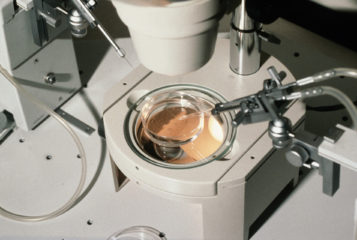This spring, an international forum on 'Changing Fertility: Social, Demographic and Ethical Consequences of Assisted Conception Technologies' was held in Cambridge, bringing together academic researchers, health professionals and policy makers. This event, which was jointly organised by the Reproductive Sociology Research Group and the Philomathia Programme at the University of Cambridge, laid the groundwork to explore changing fertility trends amid the rapidly growing industry of assisted reproductive technologies (ART). The spread of ART has brought renewed hope to many couples and individuals with difficulties conceiving, and stretched the biological age limits of childbearing. However, these new technologies are still limited in their ability to overcome age-related infertility.
The forum provided an opportunity to revisit some of the common myths and misconceptions about ART and infertility. Lone Schmidt, an Associate Professor at the University of Copenhagen, noted that infertility - defined as a failure to conceive after one year or more of regular unprotected sexual intercourse – affects around one in six couples in developed countries. In addition, she noted that while there is an almost exclusive focus on women when addressing issues of reproduction, nearly 40 percent of cases of infertility are male-dependent, as a result of poor semen quality. This is similar to the share of female-dependent infertility, while other cases are either couple-dependent or due to unknown causes. Moreover, many people have poor knowledge about infertility and its risk factors. There is a tendency to underestimate the impact of advanced female age on infertility, and to overestimate the success rates of fertility treatments. Finally, she noted that even the best ART are not sufficient to overcome reduced fertility caused by advanced female age. Therefore, access to assisted fertility should go hand in hand with prevention of infertility.
This raises the question of why people delay childbearing in the first place. Tomas Sobotka, a Senior Researcher from the Vienna Institute of Demography, explained that men and women delay childbearing for very concrete reasons, including prolonged education, increased economic insecurity and less stable relationships. Therefore, while it is biologically optimal for women to start a family when they are in their early or mid-20s, this does not always match their social circumstances. This delay has exacerbated Europe's declining fertility rates and the increase in childlessness. So far, the contribution of ART in countering these trends has been quite modest. However, impact varies considerably from one country to another. For example, in countries with higher public spending on fertility treatment, like Denmark and Belgium, around five percent of births occur following ART use, compared to around one percent of births in the USA and just over two percent of births in the UK. While these figures may not seem very high, the share of ART babies among women aged 40 and above is considerably larger.
These issues may continue to spark further debate on the appropriate policy to address infertility, and the extent to which the timing of childbearing is a matter of free choice. While women potentially have different options to delay childbearing, such as using egg freezing, these options are subject to various social, economic and biological constraints. In this context, one of the main propositions stressed by forum participants is that delayed childbearing should not be understood simply as a private matter, but also as a socially and economically dependent choice. Therefore, early family formation must be supported by a change at the institutional level.






Leave a Reply
You must be logged in to post a comment.